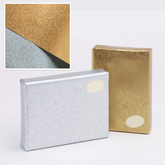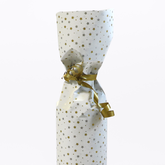Beauty brand creates plant-based glitter: Could glitter make a comeback in packaging?

The realisation that glitter is a major contributor to micro-plastic pollution came as an unwelcome shock to many packaging and ecommerce businesses – not to mention individual gift givers and festivalgoers. In response, several leading UK brands have discontinued the use of glitter in their wrapping paper and Christmas products, including Waitrose, John Lewis, and Morrisons – hardly a recipe for Christmas or Valentine cheer.
Biodegradable glitters have been available for several years, but historically they have been too expensive to produce to be economically viable on most packaging products and, furthermore, they aren’t easily recycled, so any wrapping paper treated with glitters is no longer eligible for recycling.
Bringing back the sparkle!
The development of a cost-effective, eco-friendly plant-based glitter by beauty brand Submission has therefore been greeted as welcome news by glitter aficionados, hopefully heralding the return of the sparkle to festive gift wrapping.
What is the problem with micro-plastics?
Micro-plastic pollution is exceptionally problematic for our planet's ecosystems. These plastic particles that measure 5mm or less in size can be found almost everywhere, and make their way into the food chain through aquatic life, frequently resulting in them ending up on our plates. Humans are estimated to ingest up to 5 g of micro-plastics every week. Research in 2020 by Australia’s National Science Agency discovered micro-plastics embedded in the seafloor, in core sample from Arctic ice, and in the digestive systems of whales.
Micro-plastics also pollute the air when they become airborne due to wind, weathering, and other processes, and absorb toxins from the environment which then get transferred to humans, plants, and other animals who interact with them.
Especially worrisome is the failure of current methods of recycling at ridding the world of micro-plastics. Many micro-plastics are recyclable in principle, but their small size and sheer ubiquity in the world’s oceans and landfill sites makes identifying and filtering them difficult. Consequently, micro-plastic pollution is an issue that requires better education among producers and consumers alike to minimise the use of small-scale plastic and metallic items in consumer goods, as well as increased research into more effective means of identification, collection, and disposal to tackle this growing problem.
Are plant-based biodegradable glitters the solution for eco-friendly wrapping paper?
Plant-based biodegradable glitter is a unique and eco-friendly alternative to traditional plastic and aluminium glitters. Not only does it have the same eye-catching sparkle and shine, but it also is free from the skin irritants that have traditionally made glitter problematic in cosmetic and packaging products.
The plant-based glitter created by Submission, in collaboration with Ganni, is made of plant cellulose extracted from wood pulp, making it both biodegradable and widely recyclable. Other similar products are made with edible food safe ingredients such as mica and carnauba wax, both of which are derived from plant sources.
This allows the glitter and products that contain it to decompose naturally and not contribute to the issue of microplastic pollution caused by traditional plastic glitters. Although intended primarily for beauty products, similar innovations could be replicated for packaging additives, which would be a very positive step in making packaging more sustainable and eco-friendly.
Download our free Sustainable Packaging Guide
If you are looking for cost-effective ways of creating more eco-friendly wrapping paper and packaging without sacrificing its sparkly appearance, please download a copy of our free Sustainable Packaging Guide by clicking here.
Image Source: Pexels






